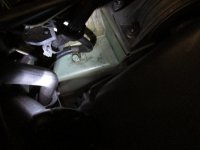Hi all,
I've had an issue starting my van in the last 24 hours and haven't been able to troubleshoot. Just wondering if there are any thoughts? Here is the breakdown of events:
Starting attempt #1-
- First ignition position- some dash lights came on, headlights came on, no fuel prime sound heard
- Attempted to start engine- would not start but kicked over started motor. Attempted a few times.
- Switched headlights off
- Switched ignition off
- Attempted first ignition position- no lights working
Starting attempt #2 & 3 (the next morning after no luck troubleshooting)-
- Started normally and ran for approx 10 mins
Starting attempt #4 (end of the same day)-
- First ignition position- accessories lit up as normal, headlights on, fuel prime heard
- Switched headlights off
- Started engine normally, ran for 1-2 mins
- Switched headlights on- engine immediately cut out
- Ignition off- faded/flickering battery light and oil light illuminated even when key is out
- First ignition position- only same lights as above plus hand brake light for approx 5 seconds then extinguished, and radio ON button only (it usually completely switches on). No other dash lights, headlights, radio power or fuel pump. Ie accessories aren't working as usual on startup
- Started motor engaged but engine doesn't start
With the key out there's still a faint and flickering battery light and illuminated oil light.
We checked the mega and midi fuses and all appear to be intact so can't work out what it may be. One of the theories is something with the ignition circuit/barrel
Thanks!
I've had an issue starting my van in the last 24 hours and haven't been able to troubleshoot. Just wondering if there are any thoughts? Here is the breakdown of events:
Starting attempt #1-
- First ignition position- some dash lights came on, headlights came on, no fuel prime sound heard
- Attempted to start engine- would not start but kicked over started motor. Attempted a few times.
- Switched headlights off
- Switched ignition off
- Attempted first ignition position- no lights working
Starting attempt #2 & 3 (the next morning after no luck troubleshooting)-
- Started normally and ran for approx 10 mins
Starting attempt #4 (end of the same day)-
- First ignition position- accessories lit up as normal, headlights on, fuel prime heard
- Switched headlights off
- Started engine normally, ran for 1-2 mins
- Switched headlights on- engine immediately cut out
- Ignition off- faded/flickering battery light and oil light illuminated even when key is out
- First ignition position- only same lights as above plus hand brake light for approx 5 seconds then extinguished, and radio ON button only (it usually completely switches on). No other dash lights, headlights, radio power or fuel pump. Ie accessories aren't working as usual on startup
- Started motor engaged but engine doesn't start
With the key out there's still a faint and flickering battery light and illuminated oil light.
We checked the mega and midi fuses and all appear to be intact so can't work out what it may be. One of the theories is something with the ignition circuit/barrel
Thanks!


